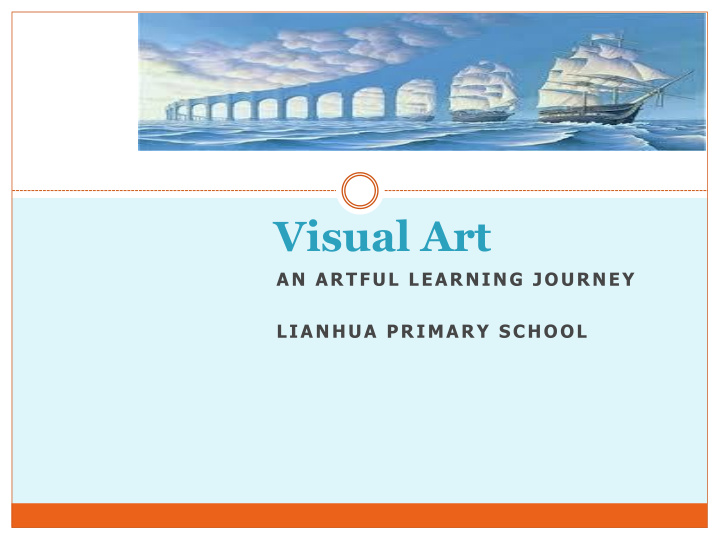



Visual Art AN ARTFUL LEARNING JOURNEY LIANHUA PRIMARY SCHOOL
A Thought to begin with… Video- 2016 P1 students in their art making process and artworks
Today’s overview… What is the role of Art? Content Art Forms Elements of Art Principles of Design Understanding Children’s Drawing Tips for Developmentally Practices in Facilitating the Growth of Drawing Skills Hands- on Art Activity at Parent’s Workshop - Jurong Health Service Community Outreach Art Project – Making Chinese New Year and Get-Well Greeting Card Q n A
What is the Role of Art? Role of Art in Students’ Growth and Development Develop visual literacy (i) (a) Observe, understand and make meaning of what they see (b) Communicate their ideas using and creating visuals Encourages the development of creativity (i) (ii) Develop self-confidence and sense (iii) Equip pupils with the skills to better understand and engage with the world they live in.
Content Values of Art (i) Captures imagination (ii) Expresses human emotions (iii) Communicates ideas (iv) Purposes and functions (v) Role in society and culture
Content Skills Art Techniques (i) Drawing, painting, moulding, rendering using digital media. • Visual Inquiry Visible Thinking Approach i.e See/Think/Wonder (i) Research and Processing Observe, record, compare (i) Communication (i) Express ideas visually and orally
Art Forms Fine Art 2-dimensional (i) Drawing, painting, collage 3-dimensional Assemblage (i) • Digital Media (i) Photography with i-Pad Research and Processing Observe, record, compare (i) Communication (i) Express ideas visually and orally
Elements of Art Visual Characteristics (i) Dot (ii) Line (iii) Shape (iv) Form (v) Colour (vi) Texture (vii) Space (viii) Tone
Principles of Design Ways to arrange the elements (i) Scale (ii) Balance (iii) Proportion (iv) Pattern/ Repetition
P1 Pupil’s Art Materials (i) Sketch Book (Drawing, Reflection and Journal) (ii) Colour Pencils (iii) Oil Pastels (iv) Two 2B pencils, sharpeners, erasers and ruler
Understanding Children’s Drawings Once I drew like Raphael, but has taken me a whole lifetime to learn to draw like children. Quoted by Pablo Picasso
Understanding Children’s Drawings Development of Visual Art Abilities How children see things (Perception) How they think about things they see (Conceptualisation) How they actually represent what they see and think (Production)
Perception- What do children see..? Refers to the way we see Unfolds over a lifetime When children are making art, they are interested in the subject matter as well as how the drawing is made. Shapes, lines, forms and colours all become very important to children.
Conceptualisation – How do children think about what they see? Refers to children’s levels of understanding of visual art. At Primary school level, children tend to produce works of art based on some notion of favourite person, place or colour. In the later part of childhood, children will start relating aspects of their works to their own emotions.
Production – What do they produce as a result of what they see and think? Take various forms of expression i.e drawing Drawing itself is a language and can be used to represent and communicate many important things in a child’s environment Children conveys emotions such as happiness, humour, pain and sadness are also evident in the way children choose to represent objects and people. Appropriate questions can stimulate awareness of their environment and in turn help children produce quality drawings.
Children’s Internal Processes and Environmental Influences Factors bring about development in visual art Jean Piaget Through the cognitive processes, children learn to accept new ideas and adapt them according to their own understanding of the world. Children’s proficiency in drawing depends on aptitude and motivation and opportunity to draw, Alexander Alland Children’s drawings are influenced by their culture Environmental influences i.e stimulation from external environment (art museum, gallery visits etc)
Tips for Developmentally Practices in Facilitating the Growth of Drawing Skills Ensure children are able to relate the artwork to their own experiences Cater to children at each developmental level, set appropriate targets and expectations Encourage children to reflect on their works Provide a cumulative record of their progress in drawing through portfolio
Tips for Developmentally Practices in Facilitating the Growth of Drawing Skills Provide a safe environment to explore art and zone of proximal development to determine how much assistance a child would need to reach his/her potential. Provide exposure for children for external stimuli i.e Art Museum, National Gallery, the surrounding etc. Provide opportunities for children to express themselves in their artwork and explore with different medium.
Perception https://www.youtube.com/watch?v=I9ficvPdpZg
Hands-on Activity – JurongHealth Service Community Outreach Art Project Our P1- P6 students and staff will be involved in the 2017 Community Outreach Art Project with Jurong Health Service to create 800 Chinese New Year cards. Objective: To make get-well and Chinese New Year Greeting cards for patients who are unable to discharge from hospital during Chinese New Year and to spread festive cheers. Values : Empathy, Motivation, Responsibility.
Q n A
A Thought to ponder
Recommend
More recommend